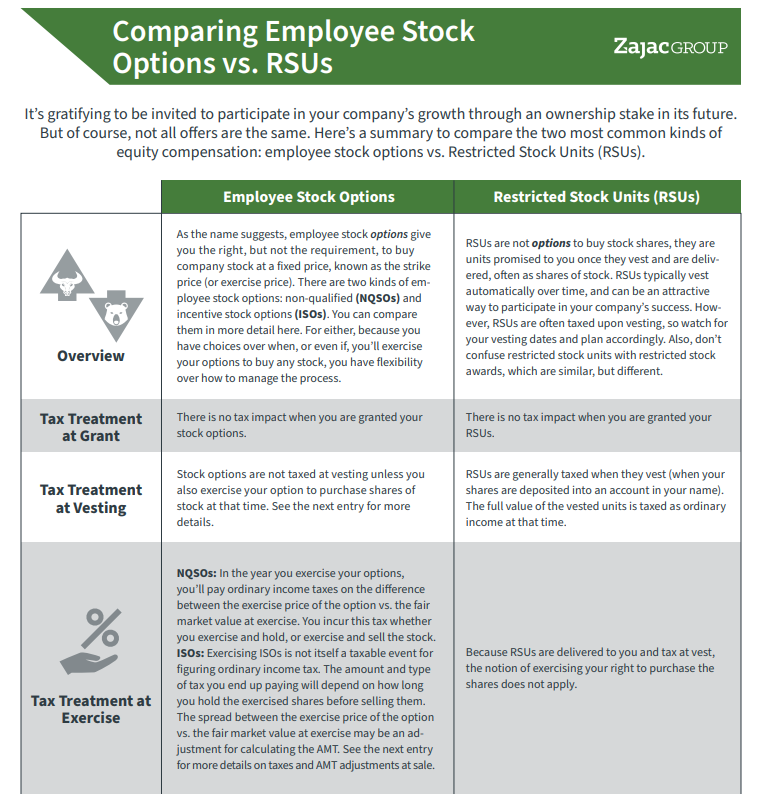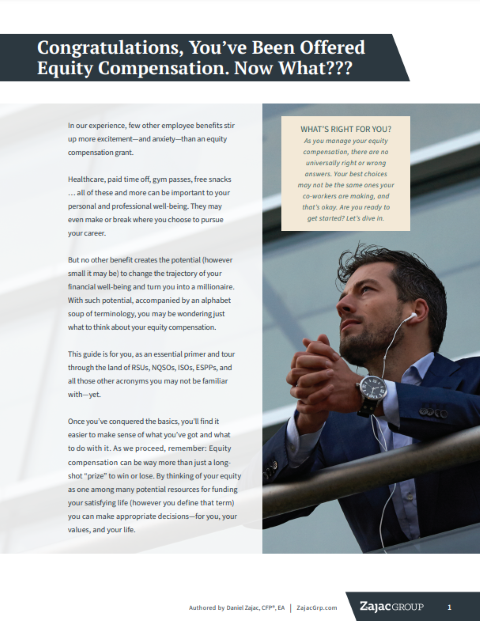Equity compensation is an effective tool for attracting and retaining highly qualified employees. But if you’re like most Americans, it’s unlikely you’ll remain with your current employer all the way through to retirement. The average length of employment is just shy of four years, though this does vary by industry.
While we tend to focus on managing your equity compensation as an employee, there’s another important piece to the equation—what to do with your options post-termination.
Upon any termination of employment, you still have the right to exercise your vested stock options as discussed below. However, any options that have yet to vest are typically canceled and forfeited, although there may be exceptions in the event of death, disability or retirement.
If you’ve already exercised your incentive stock options (ISOs) or non-qualified stock options (NQSOs), those shares are yours to hold or sell as you see fit (barring any other restrictions)—regardless of employment status. But if you have vested options yet to be exercised, terminating employment may prompt rather fast action. In most cases, you may have just a couple of months to decide.
What Is a Post-Termination Exercise Window?
When your employment with a company is terminated, the post-termination exercise window (PTEW) begins. This period, detailed in your stock plan documents/agreements, is often 90 days. When that’s the case, you have 90 days to exercise your vested stock options or run the risk of losing them. This is true even though the expiration date of the stock option likely extends beyond the 90-day post termination window.
While 90 days may feel like enough time to exercise your options at first glance, it can impose certain challenges that should be addressed (ideally well before termination).
COMPARISON GUIDE
Not All Stock Offers are the Same! Here's a helpful comparison between two of the most common employee stock options.
Exercising Incentive Stock Options (ISOs)
ISOs offer tax advantages if exercised, held, and sold as part of a qualifying disposition. Specifically, you can benefit from paying long term capital gains tax rates instead of ordinary income tax rates on the increase in value above the exercise price.
To do this, you’ll need to sell your ISOs in a qualifying disposition and meet the following two criteria:
- The final sale of the stock must occur at least 2 years from the grant date of the stock option, and
- The final sale of the stock must occur at least 1 year from the exercise date of the stock.
ISOs that do not meet this requirement will be considered a disqualifying disposition and subject to ordinary income and short-term (or long-term) capital tax rates.
When you exercise with the expectation of holding the shares for a qualified disposition, no immediate income tax is due. However, the bargain element at exercise is an adjustment for determining any potential AMT liability.
As an aside, it’s possible that your ISOs have a post-termination exercise window that is longer than 90 days. If they do, the IRS mandates that you exercise within 90-days post termination to retain the ISO status. Otherwise, the ISOs turn into NQSOs.
If you have ISOs that have a PTEW that is longer than 90-days, there may be additional complexity in the planning, particularly if your company is private. Do you exercise and hold your options prior to the 90-day window to retain the potential for qualified tax treatment (knowing you may never be able to sell the private company stock)? Or do you wait to exercise, choose the less aggressive position to retain unexercised NQSO, and wait for a liquidity event to occur (one that may never come)?
Non-Qualified Stock Options (NQSOs)
NQSOs are taxed at exercise on the difference between the exercise price (usually the stock’s fair market value on the grant date) and the fair market value on the exercise date. This is called the bargain element, and it is taxed as compensation income and also subject to Social Security and Medicare tax, if applicable. The full bargain element is taxed, regardless of whether you exercise and hold stock or exercise and sell your stock right away.
If your NQSOs are from a public company with a liquid market, an exercise within the 90-day PTEW (or longer, if applicable) often makes sense, assuming the current value is above the exercise price. If you have NQSO in a private company without a liquid market, the decision to exercise the option, hold the shares, and cover the associated costs becomes significantly more complicated, as you’ll need to cover the costs of exercise and the tax, and may never be able to sell the stock.
The Potential Cash Required to Exercise
Once employment ends, the clock starts ticking for employees with remaining unexercised vested options. Depending on the circumstances, you may be leaving your company with many unexercised options. It’s not unreasonable to see these options valued at tens of thousands—even hundreds of thousands—of dollars, or more.
If you fail to act within this short window, you may be forced to forfeit your unexercised stock options and lose their intrinsic value. It’s reasonable to assume that if you’re part of a public company and have the ability to sell stock, you’ll want to exercise the option (more on private company stock options below).
If you want to exercise during the PTEW, you will need to be able to cover the costs to do so. This could include the cost to buy the shares at the exercise price of the options and/or the cost of the tax due at exercise (or because of exercise). Often, this can be paid in part or whole by a cashless (or net) exercise of your options.
Even If Cash Flow Isn’t a Concern, Concentration Should Be
If you’re able to exercise your options and cover the full cost (and tax consequences of exercising) without putting a strain on other areas of your financial life, then your considerations here look a little different than most. Perhaps you’ve been preparing well in advance for your exit and building a cash reserve to cover the cost of a post-termination exercise.
Even if there are no concerns with the cash flow challenge of exercising all outstanding shares, you should still consider the potential impact on your portfolio. Ninety days is a relatively short amount of time to be exercising a large sum of shares. Depending on the rest of your portfolio’s asset allocation, it could tip the scales and expose your portfolio to concentration risk.
Should you immediately sell shares after exercising? Or hold and wait for a potential increase in value? If you plan on holding the majority of your shares, will your portfolio become too concentrated in your previous employer stock? What are the tax consequences of waiting to sell, and are the perceived benefits worth it??
These are important considerations to discuss with your financial advisor and tax professional.
Important Factors to Consider
Anyone considering an exercise decision within the 90-day window should take the following factors into account.
Addressing Liquidity of a Private Company Stock
As we’ve already established, you need to pay the strike price to exercise your option and acquire the shares. In addition, you’ll need to cover any projected tax due.
If you hold shares of a public company, generating cash to cover these needs is simple, as you can sell some or all the shares.
However, if you own options of a private company with no liquid market and no ability to sell the exercised shares, you’ll need to cover the cash requirement in another way. For example:
Let’s say at termination you have 10,000 shares of ISOs with a strike price of $5 a share that you wish to exercise and hold. The total cost to exercise the option is $50,000.
Let’s also assume you’ll owe AMT tax on the exercised ISOs. If the fair market value at exercise is $35 a share, the total bargain element is (10,000 shares x ($35-$5) = $300,000). Assuming a 26% AMT rate, we can estimate you will owe $78,000 in AMT.
Thus, your total due for exercising and holding your incentive stock options is $128,000 ($50,000 exercise price + $78,000 AMT).
Again, assuming no liquid market to sell the stock, you will need to cover the costs out of pocket.
Blackout Periods
Some companies impose additional restrictions on post-termination exercises. Your company’s particular policies should be outlined in your equity grant paperwork, or you can ask your HR department for more information.
If you work for a private company, you may be more likely to experience special circumstances, like an IPO or acquisition, that could impact your options. If this occurs around the same time you leave your company, your post-termination exercise window may be extended.
Early Exercise
Depending on your company’s policies, you may have the ability to exercise stock options before they vest. This is known as an early exercise. If you receive options of a start-up and/or know you’ll be leaving your company soon, you may want to consider if an early exercise makes sense (assuming your company allows it).
An early exercise would enable you to begin the holding period, meaning you could potentially meet the criteria for a qualifying disposition sooner. Exercising earlier may also reduce the spread between the FMV at exercise and the strike price, which could help lower or even eliminate your potential AMT liability.
Extending the 90-Day Window
While the 90-day PTEW is common among employers, your employer may also grant extensions on a case-by-case basis. However, if the employment termination is due to certain circumstances, like death or disability, the ISOs may be able to retain their tax-advantaged treatment for longer than the IRS 90-day imposed rule.
If a company is preparing for a major event—IPO, merger, or acquisition—they may opt to extend the PTEW. Pinterest, for example, extended its post-termination exercise window to seven years for employees who left the company before its IPO. Doing so can, of course, help employees avoid the cash flow crunch of exercising options in a tight window, especially while the company is still private.
Should You Use It or Lose It?
If you have vested options when you leave your company, you could be leaving money—and opportunity for growth—on the table. On the other hand, it takes some significant capital and strategizing to exercise all remaining options within a three-month period.
If there’s no liquid market (meaning you can’t just sell shares on the stock exchange), exercising could mean tying up a significant amount of cash with no guarantee of when you’ll be able to sell. As an employee leaving a private company with vested options, consider
- Does the company offer additional support or opportunities for employees leaving with vested options?
- What’s the company’s financial health? Are they on a positive track in terms of revenue growth and profitability?
- Have higher-ups expressed confidence in a liquidity event occurring sometime in the near future?
- That even if the company looks good now, exercising private company stock options is often considered a risky strategy, and you’ll tie up cash with no assurances of return.
For public company employees, you may have the additional option of freeing up your cash flow and pursuing other strategies, like a cashless exercise, during the PTEW.
In either case, remember that the total cost of exercising often goes beyond the strike price. You’ll also need to consider potential tax liability, as well as future investment opportunities you may not be able to participate in because your capital is tied into your company stock (assuming you exercise and hold).
This is an opportune time to talk to your advisor about your long-term investment goals and decide if it makes sense to exercise and hold or exercise and sell your remaining options—keeping in mind that holding onto options long-term may lead to concentration risk within your portfolio.
Navigating Your Options Post-Termination? We Can Help
The interplay of tax implications, cash flow challenges, and your long-term investing goals makes navigating the PTEW an important, yet complex, process. You may find it helpful to discuss your options with a financial advisor who is well-versed in equity compensation.
If you’re considering leaving your company or recently put in your two-weeks notice, please schedule a consultation to discuss your next steps with our advisors.











0 Comments